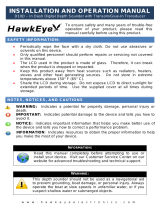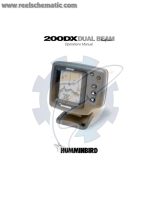
2. Preparing the Mounting Location
In this procedure, you will determine the mounting location and drill two
mounting holes, using the transducer mounting bracket as a guide.
1. Make sure that the boat is level on the trailer,
both from port to starboard and from bow to
stern, by placing your level on the deck of the
boat, first in one direction, then in the other.
2. Hold the mounting bracket against the
transom of the boat in the location you have
selected. Align the bracket horizontally, using
the level; make sure that the lower corner of
the bracket does not protrude past the bottom
of the hull, and there is at least 1/4" clearance
between the bottom of the bracket and the
bottom of the transom for fiberglass boats, and
1/8" clearance for aluminum boats (see the
illustration Boat Hull Types Require Different
Mounting Positions).
NOTE: If you have a flat-bottomed aluminum
boat, some additional adjustment may be needed
to accommodate the rivets on the bottom of the
boat (i.e. the gap may need to be a little smaller
than 1/8"). This will help you to avoid excessive
turbulence at high speeds.
NOTE: If your propeller moves clockwise (in
forward, as you're facing the stern of the boat
from behind), mount the transducer on the
starboard side, and align the bottom right corner
of the mounting bracket with the bottom of the
boat. If your propeller moves counter-clockwise
(in forward, as you're facing the stern of the boat
from behind), mount the transducer on the port
side, and align the bottom left corner of the
mounting bracket with the bottom of the boat.
Boat Hull Types Require
Different Mounting Positions
1/4” for fiberglass
1/8” for aluminum
Positioning the
Mounting Bracket
Level
Level
12
Transom Mount Transducer Installation























